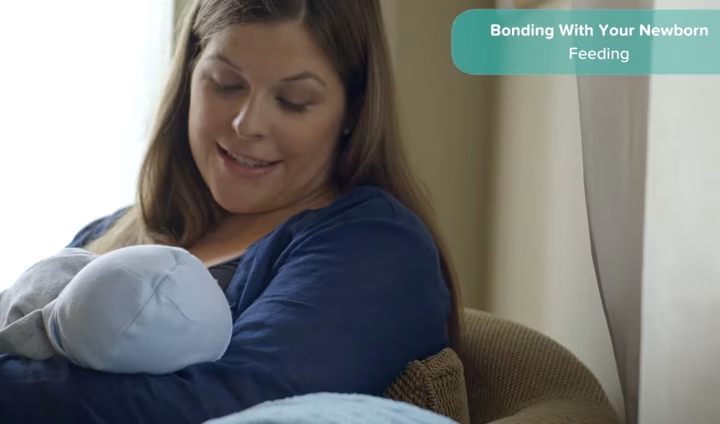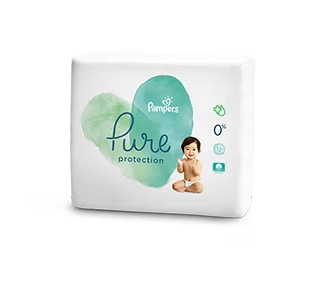Sore Nipples During Breastfeeding
During the first few weeks of breastfeeding, it’s common to experience sore nipples and other nipple discomfort, but that initial tenderness will eventually go away on its own. If it lingers, you can consult your healthcare provider or lactation consultant, as there may be another underlying cause. Read on to learn what causes sore nipples, how to treat sore nipples when breastfeeding, and when to contact your healthcare provider.
What Causes Sore Nipples When Breastfeeding?
If you recently started breastfeeding, you might be asking yourself, “Why are my nipples sore?” Sore nipples when breastfeeding—especially at the start—are common. You can break down the typical causes of this discomfort into three categories: feeding, breast health, and outside factors.
Sore Nipples and Breastfeeding
You might experience sore nipples when breastfeeding but know that they’re likely caused by a few issues you can easily address to provide relief!
Improper latch. If your baby isn't properly latched onto your nipple during breastfeeding, it could cause soreness because of friction on your nipple as your baby's mouth chafes against the skin.
Milk blister. This is a painful white spot on or around the nipple, caused by thickened milk or overgrown skin. As a result, you may need to clear blocked milk ducts.
Blister. Unlike a milk blister, a blister resulting from friction (like improper latch, a poor-fitting nipple shield, or a breast pump that rubs against your skin) can cause sore nipples.
Tongue-tie. If your baby's tongue cannot reach past their lower lip when crying—or if their tongue looks heart-shaped—it could be because the frenulum (tongue-tie) is short. A short or restricted frenulum prevents a proper latch, which in turn can be what causes sore nipples.
Not breaking the suction. If you don’t break the suction before removing your baby from your breast, you can feel soreness or pain, as well as potentially damage breast tissue and your nipple.
Sore Nipples and Breasts
The health of your breasts and shape of your nipples can also contribute to soreness when breastfeeding:
Your nipples are adjusting. It might give you peace of mind to know that sore nipples may just be your breasts adjusting to the process of nursing, especially during the first few weeks. However, the discomfort should subside once you and your baby have established a good feeding routine.
Flat or inverted nipples. Both flat and inverted nipples can prevent a proper latch during breastfeeding, which can lead to nipple soreness. Try the “pinch” test to determine if you have one or the other. Compress the areola (the dark area around your nipple) about an inch behind your nipple. If it doesn't slightly harden and become erect, then you might have what's considered a flat nipple. If your nipple retracts, then it's considered inverted.
Vasospasm. After a breastfeeding session, you might experience pain that extends from the nipple into the breast. This may be due to constriction of the blood vessels—called vasospasm—in the breast and could lead to sore nipples.
Mastitis. This breast infection, called mastitis, can happen when a blocked milk duct prevents the milk from properly getting out of your breast. The milk builds up, causing pain and swelling in your breast and nipple. Other symptoms include red streaks on your breasts, flu-like symptoms, and a hard lump in the breast.
Thrush infection. If you notice white or yellowish patches anywhere on your baby's mouth or lips, or if they have cracked skin at the corners of their mouth, it might be thrush. As a result, you might experience some symptoms, including sore nipples, shooting pains in your breast during or after breastfeeding, itchy or burning nipples, and unusually red nipples that are shiny or flaky.
Sore Nipples and Outside Factors
At times, irritation causing sore nipples might have nothing to do with how your baby feeds or your breast health. There are two main outside factors that can cause sore nipples:
Bras that are too tight. This puts pressure on your nipple and can irritate it.
Soaps or perfumes. These can cause dryness on your nipples, leading to irritation and soreness. Laundry detergent can also cause this.
Is Breastfeeding OK With Sore Nipples?
Unless your healthcare provider advises against it, try to stick to your regular breastfeeding schedule as much as possible, even if you’re experiencing sore nipples. Slowing down or stopping breastfeeding could reduce your milk production. If it’s less irritating to your nipples, an alternative option is to use a breast pump until the nipple soreness subsides. But even if you have a breast infection like mastitis, you should continue breastfeeding or pumping. In the case of mastitis, the breast pain and related sore nipples could worsen if you stop expressing milk. Likewise, in the case of thrush, it's best to continue breastfeeding unless your healthcare provider advises otherwise.
How to Treat Sore Nipples When Breastfeeding
Now that you have a better idea of what causes sore nipples, knowing how to treat them when breastfeeding is the next step. Relieving nipple pain really depends on resolving the underlying cause. Always follow your healthcare provider’s advice, but in the meantime, you might like to try some of these strategies to help provide some relief:
Make sure your baby is latching properly. The nipple should be positioned deep into your baby’s mouth. As you nurse, your baby’s lower lip should be fanned outward over the nipple rather than tucked in. If you gently pull down the corner of their mouth while feeding, you should be able to see the bottom side of your baby’s tongue, and it should be cupping the breast.
Try different breastfeeding positions. One thing that might help is trying different breastfeeding positions. Finding the position that works best for you and your baby might help prevent friction and irritation on your nipples.
Properly break suction. When you need to stop breastfeeding, instead of pulling your baby away, put your clean finger into the side of your baby’s mouth to break the suction. This action can help prevent irritation and tissue damage.
Leave some milk or colostrum on your nipples. To naturally moisturize your skin after breastfeeding, don’t wipe excess milk away and let it air-dry. However, if you find that your breast milk leaks between feedings, use bra pads and make sure to change them often.
Keep soaps away from your nipples. Water is all you need to wash your nipples, as soaps and perfumes can cause irritation. Also, it may help to fully rinse laundry detergents from your bras or shirts that come into contact with your nipples.
Use purified lanolin or gel pads. If you have sore nipples after breastfeeding, or they’re dry or cracked, applying purified lanolin afterward may help. Gel pads might also help soothe sore nipples.
Apply heat. Applying a heating pad, warming gel pads, or a wet, warm washcloth after breastfeeding can help reduce the discomfort from sore nipples.
Use breast shields. Breast shields are dome-shaped covers that help prevent irritation from clothing or your bra from rubbing against your skin, which can lead to sore nipples or other discomfort.
Treat any infections. If your healthcare provider diagnoses an infection like thrush or mastitis, follow their instructions, as you might be prescribed antibiotics or an antifungal treatment.
Ask for professional help. Don’t hesitate to connect with a lactation professional or your healthcare provider for advice on breastfeeding. It’s also important to consult your provider if your sore nipples last more than a couple of days or progressively worsen.
FAQS AT FLANCE
This pain might be due to vasospasm, which is when the blood vessels in the breast constrict. Applying a heating pad or warming gel pack after breastfeeding might help.
The Bottom Line
It’s not uncommon to experience sore nipples at some point in your breastfeeding journey. Know that you can enjoy breastfeeding—free from major discomforts—if you take a few preventative steps and care for your nipples!
The information in this article is based on the expert advice found in trusted medical and government sources, such as the American Academy of Pediatrics and the American College of Obstetricians and Gynecologists. You can find a full list of sources used for this article below. The content on this page should not replace professional medical advice. Always consult medical professionals for full diagnosis and treatment.
Join Pampers Club and get:





